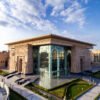Egypt. The name itself conjures images of colossal pyramids piercing a desert sky, golden treasures of boy-kings, and…
Egypt, the land of Pharaohs, enigmatic pyramids, and the life-giving Nile, is a destination that captures the imagination…
The year 2027 marks a celestial event of monumental proportions—an astronomical phenomenon so rare, so spectacular, and so…
The universe holds few spectacles as profoundly moving and awe-inspiring as a total solar eclipse. It is a…
The cosmos operates on a timescale far beyond our human comprehension, yet occasionally, its gears align to produce…
The total solar eclipse on August 2, 2027, is not merely another astronomical event; it is widely hailed…
Egypt is not just a land of colossal temples and pyramids; it is a repository of human history…
Egypt is globally renowned for its monumental history—the colossal Pyramids of Giza, the majestic temples of Luxor and…
Few places on Earth captivate the imagination and stir the soul quite like Egypt. This ancient land, the…
For centuries, the Nile River has been the lifeblood of Egypt, a timeless artery carrying a stream of…
Embarking on a Nile cruise is more than just a vacation; it’s a journey back in time, an…
When one contemplates a vacation of unparalleled elegance and sophistication, the thought of a luxury cruise often comes…















